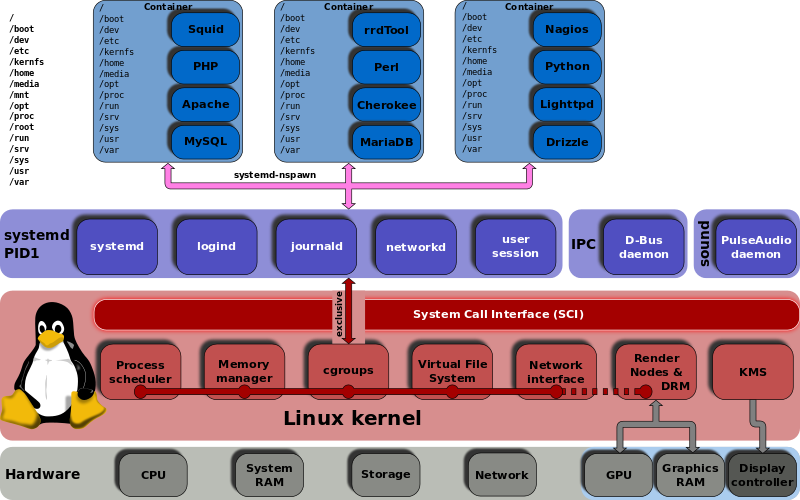http://www.linux.com/learn/tutorials/794615-systemd-runlevels-and-service-management
 In olden times we had static runlevels. systemd has mechanisms for more flexible and dynamic control of your system.
In olden times we had static runlevels. systemd has mechanisms for more flexible and dynamic control of your system.
Before we get into learning more useful systemd commands, let's take a little trip down memory lane. There is this weird dichotomy in Linux-land, where Linux and FOSS are always pushing ahead and progressing, and people are always complaining about it. Which is why I am taking all of this anti-systemd uproar with a grain of salt, because I remember when:
Which reminds me of my greatest triumph in keeping an old computer running long after it should have been retired. Once upon a time a friend had this little old 286 running some ancient version of MS-DOS. She used it for a few basic tasks like appointments, diary, and a little old accounting program that I wrote in BASIC for her check register. Who cares about security updates, right? It's not connected to any network. So from time to time I replaced the occasional failed resistor or capacitor, power supply, and CMOS battery. It just kept going. Her tiny old amber CRT monitor grew dimmer and dimmer, and finally it died after 20+ years of service. Now she is using an old Thinkpad running Linux for the same tasks.
If there is a moral to this tangent it escapes me, so let's get busy with systemd.
You can view unit dependencies, and it's always surprising to me how complex they are:

cgroups,
or control groups, have been present in the Linux kernel for some
years, but have not been used very much until systemd.
Before we get into learning more useful systemd commands, let's take a little trip down memory lane. There is this weird dichotomy in Linux-land, where Linux and FOSS are always pushing ahead and progressing, and people are always complaining about it. Which is why I am taking all of this anti-systemd uproar with a grain of salt, because I remember when:
- Packages were evil, because real Linux users built everything from source code and kept strict control of what went on their systems.
- Dependency-resolving package managers were evil, because real Linux users resolved dependency hells manually.
- Except for apt-get, which was always good, so only Yum was evil.
- Because Red Hat was the Microsoft of Linux.
- Yay Ubuntu!
- Boo hiss Ubuntu!
Which reminds me of my greatest triumph in keeping an old computer running long after it should have been retired. Once upon a time a friend had this little old 286 running some ancient version of MS-DOS. She used it for a few basic tasks like appointments, diary, and a little old accounting program that I wrote in BASIC for her check register. Who cares about security updates, right? It's not connected to any network. So from time to time I replaced the occasional failed resistor or capacitor, power supply, and CMOS battery. It just kept going. Her tiny old amber CRT monitor grew dimmer and dimmer, and finally it died after 20+ years of service. Now she is using an old Thinkpad running Linux for the same tasks.
If there is a moral to this tangent it escapes me, so let's get busy with systemd.
Runlevels vs. States
SysVInit uses static runlevels to create different states to boot into, and most distros use five:- Single-user mode
- Multi-user mode without network services started
- Multi-user mode with network services started
- System shutdown
- System reboot.
/usr/lib/systemd/system/graphical.target, which is the default on CentOS 7:[Unit] Description=Graphical Interface Documentation=man:systemd.special(7) Requires=multi-user.target After=multi-user.target Conflicts=rescue.target Wants=display-manager.service AllowIsolate=yes [Install] Alias=default.targetSo what do unit files look like? Let us peer into one. Unit files are in two directories:
- /etc/systemd/system/
- /usr/lib/systemd/system/
/etc/systemd/system/ takes precedence over /usr/lib/systemd/system/. Hurrah, human over machine. This is the unit file for the Apache Web server:[Unit]
Description=The Apache HTTP Server
After=network.target remote-fs.target nss-lookup.target
[Service]
Type=notify
EnvironmentFile=/etc/sysconfig/httpd
ExecStart=/usr/sbin/httpd/ $OPTIONS -DFOREGROUND
ExecReload=/usr/sbin/httpd $OPTIONS -k graceful
ExecStop=/bin/kill -WINCH ${MAINPID}
KillSignal=SIGCONT
PrivateTmp=true
[Install]
WantedBy=multi.user.target
These files are fairly understandable even for systemd newcomers, and
unit files are quite a bit simpler than a SysVInit init file, as this
snippet from /etc/init.d/apache2 shows:SCRIPTNAME="${0##*/}"
SCRIPTNAME="${SCRIPTNAME##[KS][0-9][0-9]}"
if [ -n "$APACHE_CONFDIR" ] ; then
if [ "${APACHE_CONFDIR##/etc/apache2-}" != "${APACHE_CONFDIR}" ] ; then
DIR_SUFFIX="${APACHE_CONFDIR##/etc/apache2-}"
else
DIR_SUFFIX=
The whole file is 410 lines.You can view unit dependencies, and it's always surprising to me how complex they are:
$ systemctl list-dependencies httpd.service
cgroups
cgroups, or control groups, have been present in the Linux kernel for some years, but have not been used very much until systemd. The kernel documentation says: "Control
Groups provide a mechanism for aggregating/partitioning sets of tasks,
and all their future children, into hierarchical groups with specialized
behaviour." In other words, it has the potential to control, limit, and
allocate resources in multiple useful ways. systemd uses cgroups, and
you can see them. This displays your entire cgroup tree:$ systemd-cglsYou can generate a different view with the good old
ps command:$ ps xawf -eo pid,user,cgroup,args
Useful Commands
This command reloads the configuration file of a daemon, and not its systemd service file. Use this when you make a configuration change and want to activate it with least disruption, like this example for Apache:# systemctl reload httpd.serviceReloading a service file completely stops and then restarts a service. If it is not running this starts it:
# systemctl restart httpd.serviceYou can restart all daemons with one command. This reloads all unit files, and re-creates the whole systemd dependency tree:
# systemctl daemon-reloadYou can reboot, suspend, and poweroff as an ordinary unprivileged user:
$ systemctl reboot $ systemctl suspend $ systemctl poweroffAs always, there is much, much more to learn about systemd. Here We Go Again, Another Linux Init: Intro to systemd and Understanding and Using Systemd are good introductions to systemd, with links to more detailed resources.

No comments:
Post a Comment